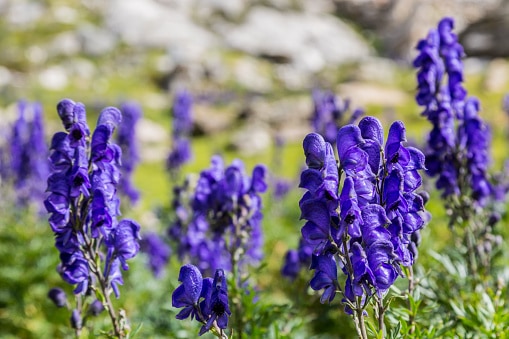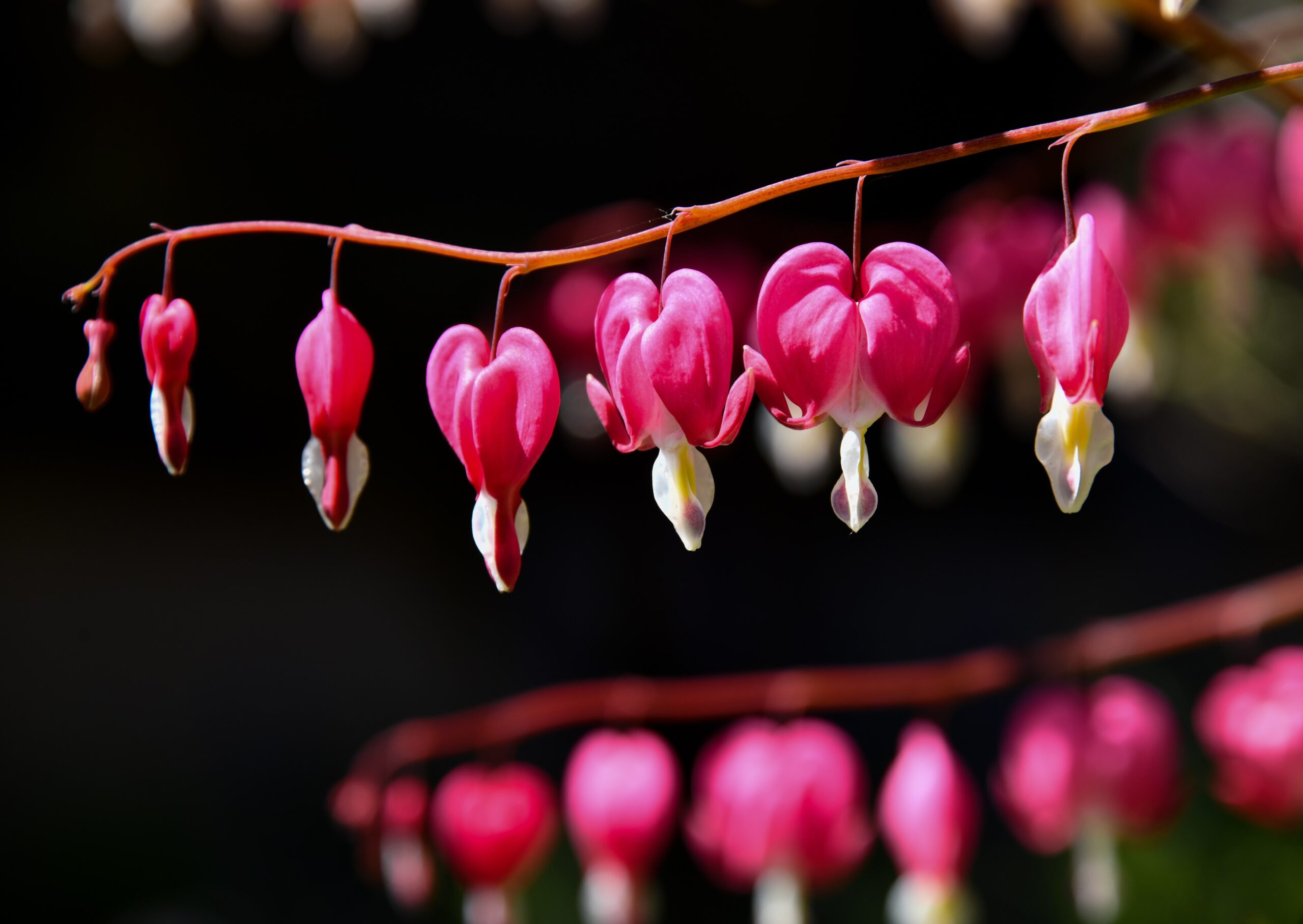The Wolfs Bane, Aconitum Napellus, is classified under the buttercup family, also known as Ranunculaceae. It is a type of biennial flower which produces spikes of showy blue ear-shaped flowers that bloom in mid to late summer. It is native to the northern hemisphere and needs full to partial sun. Also known as the Devil’s Helmet or Queen of Poisons, this toxic plant needs to be handled with care (and gloves!). It also needs to be planted away from places where children and pets could find it.
How to Plant
Wolfs Bane is a great choice for both indoor and outdoor potting. When planting outdoors, choose an area with full to partial sun and free-draining soil. When planting in a pot or container, choose a pot that is twice as large as the plant’s root system, and that has drainage holes. Aconitum Napellus needs to be watered regularly throughout the active growing season, though the soil should be allowed to dry out slightly in between waterings.
Make sure to provide fertilizer regularly, using balanced phosphorous and nitrogen fertilizer with a medium ratio. Additionally, adding a compost or organic matter to the soil at the base of the plant will help to retain moisture and provide nutrients. Keep the plants away from excessive heat, as this can cause the foliage to wilt and yellow. Deadheading the flowers and removing all dead or wilted leaves or stems will help to keep the plant looking healthy.
Meaning and Symbolism
The word “Aconitum” comes from the Greek “Akonitos”, which translates as ‘unconquerable’ or ‘invincible’. In Greek Mythology, Aconitum Napellus was believed to have been used as a weapon by Hercules to poison the Hydra. In medieval times, it was believed to have magical powers and was used to protect homes from evil entities. It has also been used both to treat and poison people, depending on the dosage.
Wolfs Bane is closely associated with the theme of death, both in its physical and metaphysical forms. It symbolizes vengeance, aboutness, and violence, so it’s no surprise that it is popularly known as the “Queen of Poisons”. Despite being embraced as a symbol of poise and resilience in some cultures, it is still rejected for its lethal qualities in others.
History, Mythology, and Religious Significance
Wolfs Bane is a herbaceous plant with a long and colourful past, used in some form or another since ancient times. It has a startlingly rich mythological background across many cultures and religions. For example, Saturn is believed to have used Wolfs Bane against his father, Jupiter. It is also said to have been used by Zeus to give the son of Midas the power of telekinesis. In Ancient Greek medicine, it was used to numb feelings of pain.
In Christianity, professionals burned Wolfs Bane in their shops to ward off evil entities. The plant is associated with the Archangel Michael, and its presence is thought to bring comfort and protection. It was also used as a symbol of respect for noble families by lining caskets with it.
Flower Varieties and Their Defining Characteristics
Aconitum Napellus, or Wolfs Bane, can be found in a variety of colors, with some, such as ‘Roseum Superbum’ and ‘Kelmscott’, having double petals. Other varieties, such as ‘Flore Pleno’, have unique, elongated petals. There are even dwarf varieties such as ‘Carneum’ and ‘Kelmscott Tricolour’. No matter the variety, they all have a characteristic that sets them apart from other types of plants – the toxicity of their foliage, stem, and flowers.
How to Pot and Repot
When potting Wolfs Bane, make sure to start with a well-draining yet humid soil mix. You should use soil that holds moisture but drains quickly, as too much moisture can cause the roots to rot. A light and airy blend made from two parts potting soil, two parts perlite, and one part vermiculite should do the trick. Additionally, choose a pot with drainage holes for the water to escape. Make sure it is large enough for your Wolfs Bane to spread.
If you are potting Wolfs Bane for the first time, begin by adding a light layer of soil to the bottom of your pot. Place the plant in the center, and then fill around it with more soil, until the roots are properly covered. Gently press down the soil, and water it. Finally, add a top layer of soil and gently spread it around the plant. Wolfs Bane prefers to be lightly fertilized and should be fertilized monthly in the outdoor summer season.
How to Prune
Pruning Wolfs Bane is easy and can ensure it remains healthy and productive for years to come. Pruning is best done after the flowering season, as it encourages the vigorous growth of new foliage the following year. The best way to prune is to remove any dead or damaged stems, and cut back the foliage to one-third of its size. Make sure to sterilize your blades with rubbing alcohol or soapy water before and after pruning so as to prevent the spread of disease.
Wolfs Bane can also benefit from deadheading, a process of removing the spent flowers during the flowering season. This will encourage the plant to re-bloom and increase its production of flower heads. In addition to pruning, it is important to trim away any severely damaged or diseased leaves or stems.
How to Propagate
Propagating Wolfs Bane is relatively easy and can be done both by seed or by division. It is important, however, to remember that Wolfs Bane needs to be divided only when the plant has become overcrowded or when its production of flowers has started to decrease. When propagating from seed, sow the seeds in peaty soil in late summer or early autumn. Make sure to cover the seed with a layer of grit or sand before covering it with plastic, and then place in a shady spot. Once the seedlings emerge, transplant them into individual pots.
Common Pests and Diseases
Wolfs Bane is generally a low maintenance plant, but can sometimes be susceptible to pests and diseases. It is important to look out for signs of a pest infestation such as aphids, mealybugs, or leafminers. If pests are found, treat them with a pesticide or an insecticidal soap. Additionally, watch out for signs of powdery mildew or root rot. If you find any of these signs, remove or treat affected parts of the plant as soon as possible.
Three Frequently Asked Questions About Aconitum Napellus
Is Aconitum Napellus poisonous?
Yes, Aconitum Napellus is poisonous, especially when ingested. It can also be toxic simply from contact with the skin, so it is important to take proper precautions when handling the plant. It is also important to take special care when gardening with children or pets around, as the plant can be fatal if ingested.
What type of soil is best for Wolfs Bane?
Wolfs Bane prefers a soil that is light and airy, and that drains quickly. A mix of two parts potting soil, two parts perlite and one part vermiculite is good for Wolfs Bane, as it will provide the right balance of nutrients and moisture. Additionally, Wolfs Bane can benefit from the addition of organic matter or compost.
What is the ideal time to plant Wolfs Bane?
The ideal time to plant Wolfs Bane is in the later months of spring, when the danger of frost has passed and temperatures have become consistently warm. Wolfs Bane should be potted in early spring, so they have time to establish before the warmer and drier months arrive. In general, Wolfs Bane needs full to partial sun and should be watered regularly.
Table Fact Sheet
| Wolfs Bane | Aconitum Napellus |
| Family | Ranunculaceae |
| Plant Type | Biennial |
| Mature Size | 1.5–2 ft |
| Sun Exposure | Full to partial sun |
| Soil Type | Light, airy, and well-draining soil |
| Soil pH | 6.7 – 7.3 |
| Bloom Time | Mid – Late Summer |
| Flower Color | Blue |
| Hardiness Zones | 3 – 8 |
| Native Area | Northern Hemisphere |
What we love from Amazon this week
Buy these wonderful flowers directly from Amazon:















